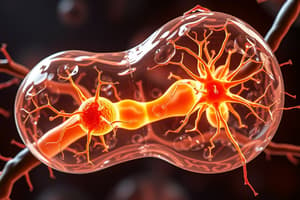Podcast
Questions and Answers
What is the principal reason we need to breathe?
What is the principal reason we need to breathe?
- To increase body temperature
- To enhance the absorption of nutrients
- To provide oxygen for ATP production (correct)
- To expel carbon dioxide from the body
Which phase of cellular respiration primarily involves the conversion of energy to ATP?
Which phase of cellular respiration primarily involves the conversion of energy to ATP?
- Phase 1: Oxidation of fuels
- Phase 2: Oxidative phosphorylation (correct)
- Phase 4: Glycolysis
- Phase 3: ATP utilization
Where does the tricarboxylic acid (TCA) cycle primarily occur within the cell?
Where does the tricarboxylic acid (TCA) cycle primarily occur within the cell?
- In the nucleus
- In the mitochondria (correct)
- In the endoplasmic reticulum
- In the cytoplasm
What are the end products of complete oxidation of the acetyl group in the TCA cycle?
What are the end products of complete oxidation of the acetyl group in the TCA cycle?
What process directly couples with the electron transport chain during cellular respiration?
What process directly couples with the electron transport chain during cellular respiration?
Which type of work does ATP NOT directly support in the cell?
Which type of work does ATP NOT directly support in the cell?
Which component of cellular respiration captures most of the energy from fuel oxidation?
Which component of cellular respiration captures most of the energy from fuel oxidation?
What is a key outcome of glycolysis in terms of ATP production?
What is a key outcome of glycolysis in terms of ATP production?
What is the primary fate of pyruvate in the presence of oxygen and mitochondria?
What is the primary fate of pyruvate in the presence of oxygen and mitochondria?
In anaerobic glycolysis, how is NADH reoxidized?
In anaerobic glycolysis, how is NADH reoxidized?
Which shuttle mechanism involves the formation and transportation of malate?
Which shuttle mechanism involves the formation and transportation of malate?
What substance is produced when malate is oxidized in the mitochondrial matrix?
What substance is produced when malate is oxidized in the mitochondrial matrix?
What happens to oxaloacetate once it is formed inside the mitochondria from malate?
What happens to oxaloacetate once it is formed inside the mitochondria from malate?
What is the primary role of glycerol 3-phosphate in the glycerophosphate shuttle?
What is the primary role of glycerol 3-phosphate in the glycerophosphate shuttle?
What is the approximate ATP yield from one mole of NADH entering the electron transport chain?
What is the approximate ATP yield from one mole of NADH entering the electron transport chain?
Which tissues primarily rely on anaerobic glycolysis due to a lack of mitochondria or diminished blood flow?
Which tissues primarily rely on anaerobic glycolysis due to a lack of mitochondria or diminished blood flow?
Flashcards
Cellular Respiration
Cellular Respiration
The process where cells use oxygen to generate ATP from fuel oxidation.
ATP
ATP
Adenosine triphosphate; a high-energy molecule used as the main energy currency of the cell
Phase 1 of Cellular Respiration
Phase 1 of Cellular Respiration
The initial stage of cellular respiration, where fuels like glucose, fatty acids, and amino acids are broken down to acetyl CoA.
TCA cycle
TCA cycle
Signup and view all the flashcards
Phase 2 of Cellular Respiration
Phase 2 of Cellular Respiration
Signup and view all the flashcards
Electron Transport Chain (ETC)
Electron Transport Chain (ETC)
Signup and view all the flashcards
Mitochondria
Mitochondria
Signup and view all the flashcards
Oxidative Decarboxylation of Pyruvate
Oxidative Decarboxylation of Pyruvate
Signup and view all the flashcards
Fate of Pyruvate (Aerobic)
Fate of Pyruvate (Aerobic)
Signup and view all the flashcards
NADH Reoxidation (Anaerobic)
NADH Reoxidation (Anaerobic)
Signup and view all the flashcards
Malate-Aspartate Shuttle
Malate-Aspartate Shuttle
Signup and view all the flashcards
Glycerolphosphate Shuttle
Glycerolphosphate Shuttle
Signup and view all the flashcards
Cytosolic NADH Limitation
Cytosolic NADH Limitation
Signup and view all the flashcards
Anaerobic Glycolysis Significance
Anaerobic Glycolysis Significance
Signup and view all the flashcards
Acetyl CoA
Acetyl CoA
Signup and view all the flashcards
Electron Transport Chain (ETC)
Electron Transport Chain (ETC)
Signup and view all the flashcards
Study Notes
Cellular Respiration
- Cellular respiration is crucial for generating ATP in cells.
- It uses oxygen to oxidize fuels (glucose, fatty acids, amino acids) to produce carbon dioxide and water.
- Over 90% of the oxygen consumed is used in this process.
Phases of Cellular Respiration
-
Phase 1: The oxidation pathways of fuels (glucose, fatty acids, etc.) converge to produce acetyl CoA.
- The acetyl group is completely oxidized to CO2 in the tricarboxylic acid (TCA) cycle.
- Energy is collected mostly as NADH and FADH2.
-
Phase 2: Oxidative phosphorylation converts the energy from fuel oxidation into high-energy phosphate bonds of ATP.
- Electrons are transferred from NADH and FADH2 to oxygen via the electron transport chain (ETC).
- This process is coupled to ATP synthesis.
-
Phase 3: High-energy phosphate bonds of ATP are used for various cellular processes, like muscle contraction and maintaining low intracellular sodium concentrations.
Location of Cellular Respiration
- Mitochondria are the site of cellular respiration.
- Components of the electron transport chain (ETC) are located in the inner mitochondrial membrane.
- The enzymes for the TCA cycle and fatty acid oxidation are within the mitochondrial matrix.
Glycolosis (Example)
- Glucose is a universal fuel for ATP generation in most cells.
- Glycolysis is the oxidation of glucose to pyruvate.
- In aerobic conditions, pyruvate is further oxidized to acetyl CoA within mitochondria.
- This acetyl CoA enters the TCA cycle.
- In anaerobic conditions, pyruvate is converted to lactate for NADH reoxidation.
- In aerobic conditions, pyruvate is further oxidized to acetyl CoA within mitochondria.
- NADH produced during glycolysis can't directly enter the electron transport chain in the mitochondria.
- It's transferred indirectly via shuttles (e.g., malate-aspartate shuttle, glycerophosphate shuttle) to regenerate NAD+ in the cytosol.
Cellular Respiration Summary
- Fuels (glucose) are oxidized to generate ATP.
- Phases of cellular respiration involve the TCA cycle, ETC, and ATP synthesis.
- Mitochondria are the locations where this process occurs.
- NADH transfers electrons to the ETC, and ATP is synthesized.
- Different schemes like the malate-aspartate shuffle and the glycerol-3-phosphate shuttle facilitate electron transfer.
Studying That Suits You
Use AI to generate personalized quizzes and flashcards to suit your learning preferences.




